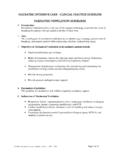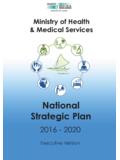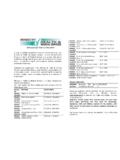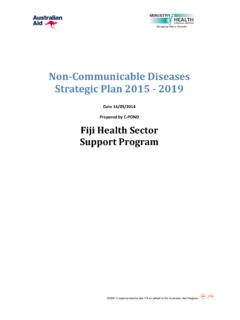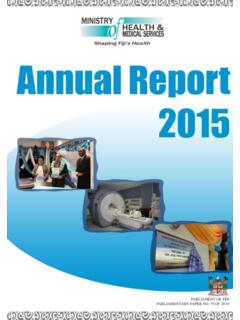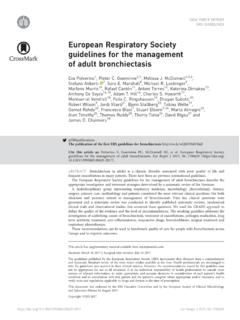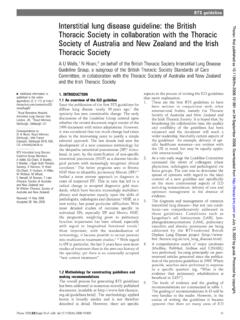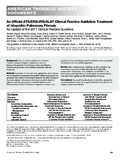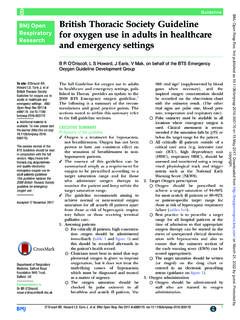Transcription of PEDIATRIC VENTILATION GUIDELINES
1 MOH_ Paediatrics Network_Ventilation Guideline_PICU_ 2010 Page 1 of 13 PAEDIATRIC INTENSIVE CARE CLINCIAL PRACTICE GUIDELINE PAEDIATRIC VENTILATION GUIDELINES 1. Introduction: Mechanical VENTILATION refers to the use of life-support technology to perform the work of breathing for patients who are unable to do this on their own. 2. Aim: The overall goals of mechanical VENTILATION are to optimize gas exchange, patient work of breathing, and patient comfort while minimizing ventilator-induced lung injury. 3. Objectives of Mechanical VENTILATION in the PEDIATRIC patient include: Improved pulmonary gas exchange Relief of respiratory distress (by relieving upper and lower airway obstruction, reducing oxygen consumption, and relieving respiratory fatigue) Management of pulmonary mechanisms (by normalizing and maintaining the distribution of lung volume and providing pulmonary toilet) Provide airway protection Provide general cardiopulmonary support 4.
2 Parameters of guideline: This guideline is intended for sick children requiring respiratory support. 5. Indications of Mechanical VENTILATION Respiratory failure apnea/respiratory arrest, inadequate VENTILATION , inadequate oxygenation, chronic respiratory insufficiency with FTT. Cardiac insufficiency/shock- eliminates work of breathing and reduces oxygen consumption. Neurologic dysfunction-central hypoventilation/frequent apnea, GCS< 8, and inability to protect airway. MOH_ Paediatrics Network_Ventilation Guideline_PICU_ 2010 Page 2 of 13 6. Initial Ventilator Settings Initial Ventilator Settings Premature neonate Neonate Infant/child Adolescent Mode Pressure control Presssure control Volume control with pressure support Volume control Rate 40-50 30-40 20-30 12-15 PEEP(cm) 3 -6/7 3 - 6 3-5 3-5 Inspiratory time(cm) PIP 18-22(if HMD) 18 20 16-18(in increased ICP); 18-25(if low compliance) 18-25;35(in severe ARDS) a) Choose the Mode-Control every breath if plan for heavy sedation and muscle relaxation.
3 Use SIMV when patient likely to breathe spontaneously. Whenever a breath is supported by the ventilator, regardless of the mode, the limit of the support is determined by : Volume limited: -preset tidal volume; Pressure limited:- preset PIP. b) Fi02-start at 100% and quickly wean down to a level < or 60%(to avoid O2 toxicity) depending on O2 requirement. 60% may be a starting point. c) I:E ratio normally set at 1:2-1:3. Higher inspiratory times may be needed to improve oxygenation in difficult situations (inverse ratio VENTILATION ), increasing the risk of air leak. Lower rate and higher expiratory time-1:3-1:4 may be needed in asthma to allow proper expiration due to expiratory obstruction. d) Trigger Sensitivity- set at 0 to -2. Setting above zero is too sensitive; triggered breath from ventilator will be too frequent while too negative a setting will increase work for patient to trigger a ventilator breath.
4 E) Volume Limited-Tidal Volume - 8-10ml/kg with a goal to get to 6-8ml/kg. If leak present around ET tube, set initial tidal volume to 10-12ml/kg. These lung-protective strategies recruit atelactetic areas while preventing over distention of normal lung parenchyma. 7. Maintanence of VENTILATION - Fine tuning after initiation is based on blood gases and oxygen saturations. Do not make more than 2 alterations at any one time. For oxygenation adjust FiO2, PEEP, inspiratory time, PIP(tidal volume) increase MAP. For VENTILATION -RR, tidal volume(in volume limited) and PIP (in pressure limited mode) can be adjusted. PEEP is used to prevent alveolar collapse at end of inspiration, to recruit collapsed lung spaces or to stent open floppy airways. MOH_ Paediatrics Network_Ventilation Guideline_PICU_ 2010 Page 3 of 13 8. Hypoxemia, hypercarbia. Gas Exchange Related Problems- What to do if : a) Hypoxemia- Increase FiO2 and MAP.
5 Need to find a balance as per clinical situation Increase tidal volume if volume limited mode, PEEP, or inspiratory time. Increase PIP/PEEP/ITime if pressure limited mode. If O2 worse, get CXR to look for air leak, if increasing PEEP decreases saturations, suspect low cardiac output due to tamponade effect of PEEP(treat by fluids and inotropes) or pneumothorax. Other measures- normalize cardiac output(by fluids and inotropes), maintain normal Hb and hematocrit(in neonates), maintain normothermia, deepen sedation/consider neuromuscular block. Common reasons include: hypoventilation, dead space VENTILATION (too high a PEEP, decreased CO, pulmonary vasoconstriction), increased CO2 production , hyperthermia, high carbohydrate diet, shivering. Inadequate tidal volume delivery(hypoventilation) occurs with ETTube block, malposition, kink, circuit leak, ventilator malfunction.
6 MOH_ Paediatrics Network_Ventilation Guideline_PICU_ 2010 Page 4 of 13 b) Hypercarbia- If volume limited: increase tidal volume or rate. If asthma- increase expiratory time to >1:3. If pressure limited: increase PIP, decrease Positive End Expiratory Pressure (PEEP), increase rate. Decrease dead space( increase Cardiac Output, decrease PEEP, vasodilator, shorten ET tube). Decrease CO2 production : cool, increase sedation, decrease carbohydrate load. Change endotracheal tube if blocked(may be remedied by suction), kinked, malplaced or out, check proper placement. Fix leaks in the circuit, endotracheal tube cuff, humidifier. Note: Increasing ventilator parameters may not be acceptable in conditions like: i. Patient ventilator dysynchrony common causes include hypoventilation , hypoxemia, tube block/kink/malposition, bronchospasm, pneumothorax, silent aspiration, increased oxygen demand/increased CO2 production(in sepsis), inadequate sedation.
7 I. Permissive Hypercapnia-higher paCO2 are acceptable in exchange for limited peak airway pressures, as long as ph> Otherwise to be discussed with Consultant. ii. Permissive Hypoxemia- PaO2 of 55-65; SaO2 88-90% is acceptable in exchange for limiting FiO2 <60% , as long as there is no metabolic acidosis. Adequate oxygen content can be maintained by keeping Hct >30%. To be discussed with Consultant. 9. If patient fighting ventilator and desaturating immediate measures include: -DOPE TROUBLE SHOOTING- D-Displacement-check tube placement. When in doubt take ET Tube out and start manual VENTILATION with 100% O2 and with bag and mask. O-Obstruction-is the chest rising. Are breath sounds present and equal? Changes in examination?. Atelactasis, treat bronchospasm/tube block/malposition/pneumothorax(consider needle thoracocentesis). Examine circulation:?Shock, ?Sepsis. P-Pneumothorax-check ABG, saturation and CXR for pneumothorax and worsening lung condition.
8 E-Equipment failure-examine ventilator, ventilator circuit/humidifier/gas source. If no other reason for hypoxemia :- increase sedation/muscle relaxation, put back on the ventilator. MOH_ Paediatrics Network_Ventilation Guideline_PICU_ 2010 Page 5 of 13 10. Duration varies by nature of disease process: HMD may take 3days to a week, pneumonia 5-7days, ARDS 10days to 3weeks and neurological illness (eg GBS) from 1week to few months. Postcardiac surgery VENTILATION may vary from 24hrs to 7days or more and postoperative chest or abdominal cases would vary from 24-48hrs. DURATION OF VENTILATION - Risk of nosocomial infection increases with VENTILATION >5-7days. 11. Weaning begins from the moment VENTILATION is commenced. When FiO2 requirement is down to 40%, improvement in secretions and CXRs, improving clinical condition or primary pathology, muscle relaxant drip is stopped and sedation slowly weaned to get patient moving and awake( may take 24hrs or longer if prolonged use).
9 WEANING FROM MECHANICAL VENTILATION - When Weaning:- Decrease FiO2 to keep SpO2>94, Decrease SIMV rate to 10 (reduce by 3-4breaths/min). Decrease the PIP to 20cm of water by reducing 2cm H2O each time/tidal volume to no less than 5ml/kg to prevent atelactasis(usually guided by blood gases). Ventilator rate and PIP can be exchanged alternately If at any time patients oxygen requirement increases greater than 60% or spontaneous VENTILATION is fast or distressed with accessory muscle use, patient gets agitated or lethargic, hypercarbia on ABGs, pause weaning and increase support level. Patient may not be ready to wean. 12. SIMV rate of < 10, but can extubate even at rate 20 EXTUBATION CRITERIA- Some will need pressure support 5-10 above PEEP with CPAP, while others may need CPAP 5cm water before extubation. Infants can usually be extubated from a rate of 5 without any period of endotracheal CPAP before extubation.
10 Infants intubated >3days usually, after extubation, require nasal CPAP, and then nasal prongs. there is control of airway reflexes, minimal secretions; patent upper airway(air leak around tube), good breath sounds, minimal O2 requirement <30% with SpO2 >94;. Also, minimal pressure support(5-10 above PEEP), Awake patient, Adequate muscle tone(squeeze examiners fingers/vigorous cough), Minimal/no inotropic support, normal electrolytes and no fluid overload. Extubation procedure- Keep NBM 4hrs before planned extubation Suction endotracheal tube and deflate cuff if using a cuffed tube. Suction the oral cavity and nostrils. Suction the NGT before removing to empty the stomach Keep oxygen by facemask ready. Nasal cannula can be taped to the face even before extubation to avoid immediate hypoxia/stress upon extubation. MOH_ Paediatrics Network_Ventilation Guideline_PICU_ 2010 Page 6 of 13 Correct size mask and bag with O2 must be available with a working laryngoscope and correct size ETTube.
